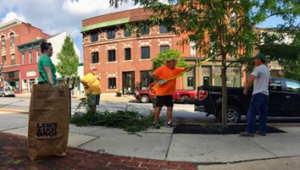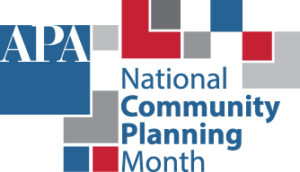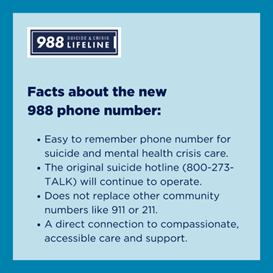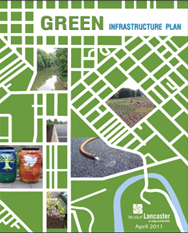The Latest News from PA Chapter of APA…
Public safety and hazard mitigation have always been important components of planning but haven’t always gotten the attention from planners that they warrant. With climate change dramatically impacting our built and natural environments and with the pandemic amplifying many people’s safety concerns, planners now know that they need to pay attention to pubic safety, broadly defined, more fully. This month, we focus on a few different aspects of public safety, including municipal tree canopies, the state’s new hazard mitigation plan, the new 988 suicide prevention hotline, and Lancaster City’s green infrastructure plan. Enjoy!
American Planning Association National Conference Update
The American Planning Association will hold its National Conference at the Philadelphia Convention Center, In-person: April 1-4, 2023 and Virtual: April 26-28, 2023.
If you are interested in volunteering to help plan the local aspects of the conference, contact our Host Chair, Alexis Williams. Thank you to everyone that has offered to volunteer to work with APA to showcase Philadelphia.
The Call for Proposals for the 2023 National Conference is open through October 12th. Sign up by October 12, 2022 if you would like to volunteer to review proposals
Congratulations to PMPEI for their 30th Anniversary! PMPEI’s municipal training is critically important in Pennsylvania, where there are so many municipalities and turnover of local officials occur constantly.
Each year the Chapter offers a scholarship to support individuals seeking funds for academic degree programs, internships, and professional development activities. If anyone would like to contribute to the Chapter’s Scholarship fund, donations can be made here. We accept all major credit cards, or you can send a check. Please make your check payable to “PA Chapter of APA Scholarship Fund” and mail it to P.O. Box 4680, Harrisburg PA 17111.
Municipal Tree Canopy in Cedar Rapids Iowa & Rethinking Resiliency Here at Home
If you didn’t see the ReLeaf Cedar Rapids feature in August’s Planning magazine, National Preparedness Month is a great time to check it out. Two years ago, the Iowa town lost over a half million trees to a severe storm with powerful straight-line winds. Since then, ReLeaf Cedar Rapids has emerged as an economical and ecologically responsible framework for reestablishing Cedar Rapids’ urban forest.
Planners in the areas of municipal management, open space and recreation, streetscape design, community development, and green infrastructure can take a proactive stance and incorporate Cedar Rapids’ eight ReLeaf Rules in their local community before a major disaster strikes. The eight rules for replanting efforts in Cedar Rapids focus on finding the right tree for the right location, balancing local character with overall species diversity, and maximizing the use of small seedlings and large canopy trees.
A few of the rules run counter to traditional wisdom in urban forestry. For example, trees do not need to be widely separated in public spaces to maintain their health, nor should they be surrounded by grass. Likewise, larger-caliper trees are not always better at planting time. If they can be protected from foot traffic and maintenance equipment, 1-inch caliper trees tend to outperform larger ones over time because their root ball suffers less damage when transplanted. 
With the increasing frequency of severe storms and the emergence of threats like the spotted lantern fly, it is well worth thinking about how your community can build resiliency into its tree management program. If your local community has a Shade Tree Commission, this appointed board is a great springboard for engaging with municipal officials and residents. In Pennsylvania, Shade Tree Commissions can be formed to regulate the planting, pruning, and removal of street trees, but many Tree Commissions also sponsor community events, perform volunteer work, maintain tree inventories, and develop planting plans. Parks and Rec boards and Public Works departments are other local entities whose activities can support municipal tree cover goals.
October is National Community Planning Month
 The American Planning Association has developed a tool kit with materials you can use to promote planning throughout the month. Here’s the online link.
The American Planning Association has developed a tool kit with materials you can use to promote planning throughout the month. Here’s the online link.
Please consider undertaking at least one of the following activities:
- Proclamation
APA has drafted a model proclamation to recognize the event. The model is designed so that it can be adopted by county and municipal governing bodies. You can request that the appropriate governing body/official adopt/approve the proclamation to designate October Community Planning Month in your county/municipality. You might also want to include the proclamation in your Planning Commission meeting agenda during October and then post the proclamation on the municipal, county, or regional website.
- LOGO and ADs
Post the logo for National Community Planning Month on your website.
- Social Media — #PlanningMonth
Use the hashtag #PlanningMonth in social media.
Any time and effort put forth in this endeavor to educate and publicize National Community Planning Month throughout Pennsylvania is greatly appreciated. The work that planners do to enhance the quality of life in Pennsylvania communities is important, and this provides an opportunity for that hard work to be recognized.
Communication and Membership Committee
The Communication and Membership Committee is looking for volunteers to contribute articles for our monthly E-News. If you are interested or would like more information, please contact Amy Evans or Amy McKinney.
PEMA Updates State Hazard Mitigation Plan
The Pennsylvania Department of Emergency Management (PEMA) is currently updating the State Hazard Mitigation Plan. The Federal Emergency Management Agency (FEMA) requires states to have a federal-approved Hazard Mitigation Plan (HMP) to be eligible for federal funding for mitigation projects. The Pennsylvania Hazard Mitigation Plan was last updated in 2018 and must be revised every five years. As a result, PEMA is currently drafting the 2023 Pennsylvania Hazard Mitigation Plan.
The Pennsylvania Hazard Mitigation Plan guides risk-informed decision making at the state level while also assisting local governments engaged in mitigation planning, including vulnerable and underserved communities. The 2023 Pennsylvania Hazard Mitigation Plan will focus on pandemic and extreme temperature hazards as well as updating information on previously identified hazards. The HMP update includes coordination among state agencies including the Pennsylvania Department of Transportation and the Pennsylvania Department of Environmental Protection. Extensive outreach to stakeholders is also underway. To learn more about the HMP update or to provide input on the plan development, visit here.
Emergency Response & 988: The New 3-Digit Kid on the Block
What is 988?
- Since July of this year, you can dial 988 to reach the National Suicide Prevention Lifeline. View the flyer.

- 988 helps people who are in emotional or suicidal distress by providing emotional support and connecting them to local resources.
- ANYONE who needs emotional or suicidal support or who needs help connecting to resources can call. Calls are FREE and confidential. 988 is available 24 hours a day, 7 days a week.
How is 988 different from 911 and 211?
- 988 is NOT 911 for mental health. First, 988 call takers cannot dispatch emergency responders in the way that 911 can. Calling 911 is still the best option for any emergency that requires immediate response. 911, on the other hand, will not be able to provide emotional support to callers who simply need to talk or be connected to behavioral health care.
- 988 also cannot geolocate calls, nor are calls always answered in the local area. In Pennsylvania, thirteen call centers answer 988 calls. Some cover very large service areas and not all operate 24/7, meaning that a 988 call made in Adams County from a 717 area code could be answered anywhere in the state or even further away depending on time of day and availability of call takers. When people are traveling, 988 will attempt to connect to a call center in their phone’s area code. The same is true for people with mobile numbers that don’t match their area code of residence.
- For people who just need someone to talk to, this usually doesn’t matter. For people who need connection to resources, it can place a counselor in a position of searching the internet for services in an unfamiliar community. 988 also emphasizes mental health and suicide prevention. If callers need other resources, 211 continues to be the most comprehensive way to find help for a wide variety of needs.
What about my local crisis hotline?
- For someone in acute mental health crisis, a local crisis hotline – especially one that offers mobile services – can be an important resource, especially if that person has interacted with the local hotline previously. The crisis response system in every community is different; your county’s Office of Mental Health & Intellectual and Development Disabilities is a good place to start in understanding how to best promote 988 in your community.
Green Infrastructure Planning in the City of Lancaster
With an extensive combined sewer system and more frequent heavy storm events, the City of Lancaster recognized that it needed to take a different, more contemporary approach with its stormwater; so, in 2011, the city adopted a 25-year Green Infrastructure Plan. This plan identified green infrastructure as stormwater management methods that:
- infiltrate (porous pavements, sidewalks, and gutters; linear infiltration systems)
- evaporate, transpire and reduce energy consumption (vegetated roofs, trees, planter boxes)
- infiltrate and transpire (rain gardens and bioretention)
- capture and reuse rainfall (rain barrels, cisterns, irrigation supply systems, and gray water systems)
 The plan went on to note that green infrastructure has many benefits, including:
The plan went on to note that green infrastructure has many benefits, including:
- Environmental – recharges ground water, provides natural storm water management, reduced energy usage, improved water quality.
- Social – beautifies and increases recreational opportunities, improves health through cleaner air and water, improves psychological well-being.
- Economic – reduces future costs of stormwater management and increases property values.
Since the plan was completed, the city has been implementing it consistently to beautify and improve the city. Planners can view these installations in person at the upcoming Chapter conference in Lancaster or can find the plan online.

